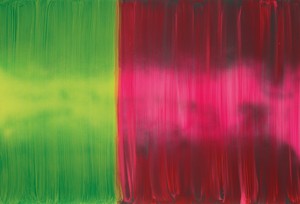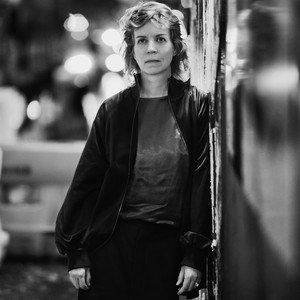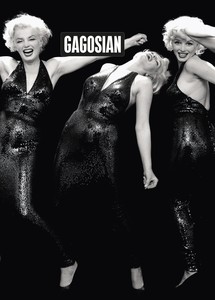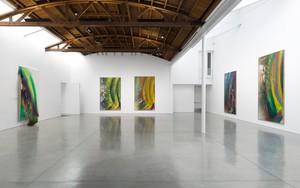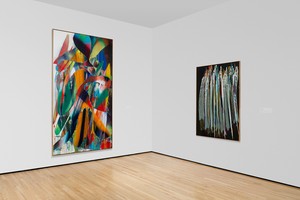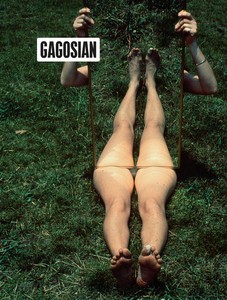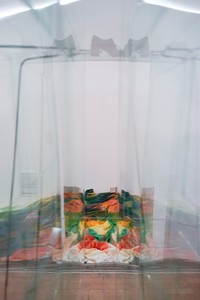Natalia GrabowskaThe project at Art Basel is outdoors and in an urban setting—very different from a contained museum setting. How do you approach different site typologies?
Katharina GrosseThe work is there only for the duration of the fair. It comes into being with the opening of the fair gates and disappears when they close seven days later. It’s commissioned by Art Basel—the biggest, most important art fair in the world—so that sets a specific tone for my approach. I’m almost painting my way out of the fair and into the world: onto the square, onto the water, onto the facade, even onto the roofs. My painting will cover a special section at the fair entrance that you can’t miss. You have to walk over it to get inside.
NGThe time frame of this project is interesting. Usually, when you do a museum show, it takes place over three or four months, and people arrive with an intention to see the work and with certain expectations. This work will be encountered by a wide variety of people in the city. If Messeplatz is on someone’s way to work or home, they’re going to walk through a very different reality that week.
KGYes, and even for visitors to the fair, as you walk through the square, you have things on your mind: maybe you had an argument with a friend, maybe you are making a mental list of the galleries you want to visit. People come to Art Basel from all over the world with very different sensibilities, experiences, and priorities. But when they walk over my piece on the Messeplatz, those varied perspectives are all sharing the same space. So, this painting at once inserts you into one kind of reality, and separates you from another. From the moment you’re on the square, it jumbles your trajectories and intentions for a brief moment. And that powerful visceral response is what interests me.
NGWe’ll have this disruption of what is usually a familiar and quite mundane setting. Suddenly, you’re turning this square into a space of imagination.
KGYes, the painting is a membrane, a threshold, between reality and imagination. You pop in and out on a large physical scale. It’s as if you inhabit the painting and are pulled into an unscripted performance. You are on it, you are moving through it, you are completely involved. You can’t focus on this little particle or that one because they are everywhere, in a state of vibration. You are following the different traces and directions and movements of the brush work. It’s almost like lines of migration.
NGBecause you’re so immersed in it as a visitor or a passerby, it’s impossible to comprehend it. You’re actively participating in this new reality and new energy.
KGYes. You are experiencing not only how you are part of it, but also how everything else is intertwined. So, the mundane functions of the square, with its flagpoles, water fountain, rooftops, and tram traffic are all connected, and here you come upon a piece that is normally not part of that world. My painting is almost like an intruder into a situation that normally repels that kind of fragile, ambiguous logic. Because the fair logic is a completely different one: it’s a logic of transaction, of market rules, of business. And my painting can’t be sold, it can’t be owned, and it will disappear just as it arrived—overnight.
NGFor this project, you only use existing architecture. It’s only painting and architecture working together; you haven’t added any other sculptural elements.
KGIn our dreams we did. [laughter] But no, the square is a platform on which so many different activities take place. What shapes it and gives it character is not only the built space, but also the interactions among the people crossing it. So, the work is also about drawing attention in an environment where competition for attention is supercharged. The magenta I use is a color of very high visibility. It’s the most visible color to the human eye in an outdoor situation, be it on the sea, on the shore, or in a city environment. The art fair in Basel has multiple textures. It has water features, it has roof structures that are almost semi-indoors, it has the big glass facade of the Hyperion Hotel, and the parking lot that serves as a billboard. So, within all of these different surfaces that cry out—Look at me! Look at me!—the surface I’m creating is coming from a very different time frame that has but one identifiable core: color. My flooding of the color transforms the black surface into something you haven’t seen before. And that kind of jolt, by forcing you out of the expected, makes you hyper-alert.
NGIt also disrupts the pristine architecture of the square—the straight lines and angles. The fountain echoes the shape of the facade, and everything is parallel, straightforward, square, organized. This all gets disrupted by introducing this new energy that comes from so many different angles. You’ve painted over the asphalt, the temporary roofs, the water fountain, the banner. There are different textures, but the painting comes together as one.
KG It was a desire for that kind of independence and freedom from my own physical limitations that led me to the spray gun. With that kind of tool, I can move so easily through all these different textures and worlds. The color can land on your shoe; it can be on a building; it can be on your design furniture at home. It is very much in the tradition of fresco painting.
NGYour interest in working outdoors stems from the time you spent in Florence, right?
KGIt does. But even as a kid, I would very organically paint on things. Even when I was older, I would just paint or scribble if I had a thought. Indeed, I’d even enjoy doing so on surfaces not made for drawing, because drawing itself—as thinking or as imagining—is a free and open process that doesn’t ever really stop somewhere.
NGDo you think of the final work as a painting, a sculpture, or something adjacent to architecture?
KGThe final work is a painting. The painting itself is almost like a large watercolor, but the way it builds this ecology with the given context makes it, of course, different. The architecture, the surfaces, and the functions of the square all play a big role in how I approach the situation. You can’t take them apart anymore. That’s how the ambiguity of the work is being created, and that is how you start to see different possibilities in something that, at first glance, looked so straightforward.
NGMovement—experienced in dance, football, tennis, and other disciplines—has always been an important interest of yours. I wonder how the choreography of your work can alter the state of affairs of the body as it moves through the work. And how you structure your own movements to create the work.
KGYou are touching upon one of the biggest differences between being in my studio and being outside. Outside, you move in relation to other people, to the material conditions, to the social conditions of a space. That’s very close to what I experience when I watch team sports or musicians playing in an orchestra. It’s always people in relation to one another who are able—even though they have very different skills—to produce an outcome that leads to a new understanding of who they are as a group. So that’s why I thought of calling it CHOIR. It’s a starting point for a multitude of voices. I was always amazed by John Cage’s experimental approach, the way he invented as a symphonic concept the paradoxical overlapping of large, shared spaces, or sounds and movement that are not flowing in the same direction.
Also, the way I structure the setup involves many steps. In Basel, it felt important to me to walk long distances. That is a specific thing here, because the square is almost a hundred meters long. To develop a movement within that is fascinating, because you can deviate and circle back. You can layer clusters of movements so that they all coalesce in one big vision. You can see the painting from far away, and at the same time you have it right under your feet.
NGYou’ve also mentioned the theatricality of this piece. The dancer and choreographer Pina Bausch has been influential for you; she’s someone you’ve watched from a very early age. You’ve also worked with Alexander Kluge on set designs. I was wondering about the staging of experience—how people will feel or perceive the work, and how they will behave in response. Is that something you think about?
KGI can’t control or influence how people specifically think or behave, of course, but I propose something that is beyond the logic of being. I offer you the possibility of a heightened state of being alive, which gives you access to how we are connected, how consciousnesses are brought together outside of what we would call our brains, for example. I’m proposing a fluid way of seeing yourself connected to a larger activity around you. I think of my painting as part of the stream. I put my hands into it and make something, and then, when I pull them out, because I’m not there anymore, it disappears.
NGDo you prepare for these works by exercising or training in some way?
KGThere are so many ways to test your body. I’ve been practicing tai chi for some years in the traditional Wu style. I have been working on all kinds of turns and rotations of the body with the help of simple weight shifts. Through these exercises, I’ve slowly changed my orientation in space. An additional challenge came up when we started to implement the weapon styles, such as the spear and fan and sword. It is a fantastic movement that only works in your body if that inner elasticity comes up, rather than the outer fabric of your muscle structure.
You have to be strong enough to carry the spray gun. That’s absolutely true. When you use it, you bring into synchronization all the prep work, all the understanding of the model that we’ve done together, but also your ability to keep the tool in your command while simultaneously discovering—in the moment—what is best for the work. The work exists like a rare flower that blooms for seven days and then disappears. It’s a kind of folly in a very mercantile space, and there is a generosity and beauty in that. It is so fragile and over-the-top, and on a surface that is not welcoming to painting. It’s like painting a watercolor under very difficult circumstances, exposing fragility, exposing a longing for the absurd. I want a poetic space within our public life.
